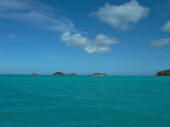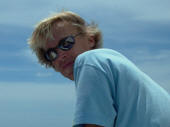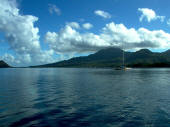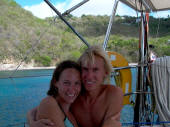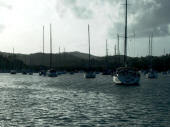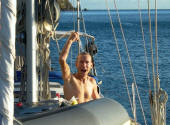
 |
|||
| West Indies 2006 |
|
||
| Southbound from Antigua to The Grenadines | |||
| ROUTE SUMMARY: |
|||
| Martinique | 28th April - 16th May 2006 | ||
| St Lucia | 16th - 21st May 2006 | ||
|
|
|||
| Page 3 of 4 | |||
|
24th - 26th April 2006: Antigua to Guadeloupe |
|||
| SOUTHBOUND AT LAST | |||
|
Our trip southwards from Antigua to Martinique would take us past the islands of Guadeloupe and Dominica. Except for the initial longer passage between Antigua and Guadeloupe, we decided to break the journey into 30 mile hops, travelling daily but not going ashore. This would make the passages comfortably short, give us plenty of time to check our anchor and get settled before nightfall and by staying on the boat we could fly our yellow ‘practique’ flag and avoid the hassle of checking in and out of each island.
Unwilling to waste any more time before heading south, we decided to check out of Antigua and depart for Guadeloupe on the same day. We knew the harbour at Deshaies on the northwest coast of Guadeloupe pretty well. As always, things take longer than expected and it was 10AM before we were heading down the coast of Antigua; Guadeloupe a speck on the horizon some 50 miles away. The wind blew from the east and, although our course was only 5 degrees east of south (175 degrees), with compensation for leeway and the inter-island current we were sailing into the wind on a fast but wet and bumpy close reach. Before long it came apparent that even crashing along at maximum speed the foul tide and the Caribbean short days were going to catch us out. To make matters worse as we rounded the headland at dusk we saw that the anchorage was packed. Threading our way carefully in the last of the day’s light we found a gap and laid out the anchor. It was too late to dive on it as we normally do and we slept lightly listening to the crashing of waves on the rocks not too far behind. The next morning found us still safely in position and we set off again down the west coast of the island.
A 30 mile slalom around the numerous and almost invisible fishing markers found us looking for a place to anchor off the unattractive and surprisingly windy capital of Guadeloupe, Basseterre. After sharing last night’s anchorage with 30 or more boats, this anchorage with only three boats felt deserted. We dug the anchor in well and even with the boat swinging this way and that in the gusty wind we felt secure. Next to us was an old chap on a small, yellow, high-mileage yacht from the UK and, to our surprise, while enjoying a cuppa, the boat turned around and floated out to sea, with no-one at the helm. We watched for a moment expecting the anchor rode to tighten and draw the boat back to safety like a dog on a long lead but after a few more seconds it was clear that, whether he wanted to or not, this man was going sailing. "Yellow boat" we hollered over and over again. Finally the old chap stuck his head out of the companionway. "Your boat is dragging" we shouted. He looked confused and sure we were out of our minds. Perhaps it was us moving? After a split second of us wondering whether we were, and him coming to terms with the fact that he was, the rescue operation commenced. He wasn't dragging but the rope attaching his boat to the anchor chain had come free*. His anchor was still somewhere on the sea bed. He didn’t appear to have a spare anchor, so Mark donned his snorkel and flippers, dived in, and went in search of the anchor. He found it, carefully attached a buoy to the end of the chain, and then climbed aboard the yellow boat and helped the old man sort himself out. He was very grateful and very relieved.
The wind howled all night, and we were glad to be on our way the next morning.
*note for our mums - we use all chain, no rope. |
Five Islands, Antigua
Leaving Antigua |
||
|
26th -28th April 2006: Dominica to Martinique |
|||
| DOMINICA | |||
|
We had a pleasant and fast sail across the channel to Dominica. By late afternoon we were swinging happily at anchor at the south end of the vast Prince Rupert's Bay. This is one of the few places to anchor in Dominica - many bays have been designated part of the National Marine Park - but at two miles long and one mile wide there is plenty of room for everyone. The water is beautifully clear with a volcanic black sand bottom. The anchor set perfectly and we slept like babies.
The following day we hopped down the west coast to Roseau, the capital of Dominica. Our arrival was somewhat disappointing. On taking a mooring we were advised us that there was a boarding problem here, with adjacent boats having been boarded by thieves just the night before. Having witnessed a boarding in our friendly Rodney Bay anchorage, we accept this is a possibility where ever we are. We were more concerned with the daylight robbery of 10US dollars for our dubious looking, old rope mooring nicely buoyed by a collection of empty coke bottles. The guidebooks say we should always dive to check on any mooring. At 28 metres deep, Mark seemed unwilling. We crossed our fingers, set the intruder alarm, and slept lightly. |
Prince Rupert's Bay, Dominica |
||
|
28th April - 2nd May 2006: Martinique |
|||
| MARTINIQUE | |||
|
Another lively close reach found us anchored off the pretty town of St Pierre, Martinique. France once more, it felt good to be in Europe again. While in St Pierre we marvelled at the awesome peak of the volcano Mount Pelee and hatched a plan to climb it. No chance. As fate tends to always dictate when we arrive in Martinique, it was a bank holiday - no buses. We hung around St Pierre for a few days, exploring the ruins of the theatre and prison. Amazingly, one of the few people to survive the 1902 eruption was a prisoner held in solitary confinement. The rest of the town, and pretty much all of its 30,000 inhabitants, were wiped out in one single day. Although St Pierre felt the perfect base for our climbing expedition, we rolled about dangerously in the anchorage. It was time to move on.
We left and struggled south into a strengthening southerly wind and short awkward chop. The easterly 15 knot wind was nowhere to be seen. It was being distorted to a southerly 15-20 knot breeze by the shape of the island and the heat of the day. As we had plenty of the day left, we decided to sail it out instead of switching on the engine and riding through it. It was great to be sailing; the challenge of working with the elements to reach the destination under our own steam alone. After a few hours of tacking (i.e. going nowhere) we knew it was unlikely that we were going to be able to make our destination - Ste Anne on the south coast of the island. Friends on 'Ragtime' had previously recommended we visit the anchorage of Petite Anse d'Arlet on the south west coast and there seemed like no better day to tuck in here and wait for better conditions.
We dropped anchor in the quiet, southern corner of the anchorage and marvelled at the crystal clear water. To our dismay there also seemed to be a large number of small, jellyfish-like creatures floating around. We have noticed these more and more over the past couple of weeks. Through the night the anchor rode made quite a lot of noise as the gusty wind shifted the boat from side to side. Mark looked at it the following morning and found that incredibly it had hooked itself under a rock and then closer to the boat had wrapped a complete turn around a substantial under water shrub. We untangled it eventually and moved to a much better spot in the anchorage. The jellyfish had gone today (where?) so we snorkelled around for hours together looking at the coral and swimming among shoals of small fish darting this way and that. In the evening we wandered around the small town and sat with drinks on the town pier watching the sun go down and the locals packing away after their bank holiday weekend.
It was time to move on and early the next morning (before that strong southerly had a chance to develop again) we set off around the headland past the imposing Diamond Rock and into the busy anchorage of Marin. |
St Pierre & Mt Pelee, Martinique
Petite Anse d'Arlet, Martinique |
||
|
3rd - 16th May
2006: Martinique |
|||
| CHORES & CLIMBING | |||
|
This is our third visit to Marin, a bustling French port we have come to like. We first visited with Margaret and Rodger within days of arriving in the Caribbean, and Marin with its dirty harbour and busy streets felt a long shot from the paradise we had anticipated. However, after a number of months experiencing new places and people, it felt good to be once again winding our way up the familiar channel into Marin.
The harbour was still packed but the boats lay more sparsely than before and we easily found a place to anchor quite near the town. We reversed on the anchor and felt happy it was dug in nicely. At six metres deep you can't see the bottom, and believe us, you ain't going in to have a look. We soon got about the business of being busy; reprovisioning for our trip south and searching for jobs for when we are back in the UK in July. Numerous, unmemorable days passed us by.
Tired with all the chores, we thought back to our old plan to climb the volcano in the north of the island - Mount Pelee. After some investigation we found out that it was cheaper to hire a car for the day than to use the buses. With lunch packed, we set off one morning on our inland adventure. Once past the traffic of the capital Fort de France, we climbed high into the rain forest on quiet, windy roads. The town of Morne Rouge sits at the foot of Mount Pelee and on our arrival the mountain was disappointingly nowhere to be seen. Being British, a little bit of cloud didn't bother us and so we pressed on. The two hour hike to the summit was a continuous, steep climb. Breathless, we reached the summit and drank in the cool, mountain air. The clouds swirled around us and the rain lashed down as we peered into the crater below with its peaks formed by subsequent eruptions, the most recent in 1929. It felt a little sinister to be standing at the top of this volcano, which in times gone by had laid everything in its path to waste. But, as we sat there alone, sheltering from the rain, our minds wandered to our times gone by, to walking in the hills of England, and we felt happy to be here surrounded by greenery, quietness and fresh, cool air. |
Marin anchorage
Walking in the clouds, Mt Pelee |
||
|
15th - 21st May 2006: Martinique, St Lucia & Bequia |
|||
| MOVING ON FROM MARTINIQUE | |||
|
Looking at the state of our anchor rode (chain), the time had definitely come for us to leave Marin. We were starting to look like true 'live-aboards' with a thick layer of weed starting at the water's surface and extending down into the murky depths. It look us a while to scrub it off and, as the anchor released itself from the mud, our Polish neighbour for the past two weeks shouted something about a 'tropical wave' and were we aware of it? "Oh yes, definitely" we said, shaking our heads from side to side while shooting questioning sideway glances at each other. We pulled into one of our favourite anchorages just outside Marin - Ste Anne - and proceeded to clean Free Spirit's weedy hull and to pick up some more detailed weather info.
Every day we receive a text weather forecast via our Single Side Band (SSB) radio and we have found this to be sufficient and fairly accurate during the time we have been in the Caribbean. However, we are soon to enter the hurricane season (July - Nov), and what we now know is that an early feature of this season tends to be 'tropical waves', where areas of disturbed weather (squalls and thunderstorms) group together and, in the right conditions, could progress into a bigger storm, and even a hurricane. This particular tropical wave passed over the southern end of the East Caribbean presenting no great danger for us. As we still have about 200 miles to travel to reach Grenada we thought it wise to receive a daily text discussions on major weather systems in the Atlantic. Feeling a little more weather savvy, we set off the next day for St Lucia.
It was a beautiful morning and with plenty of room in the anchorage we decided to be a bit more adventurous than normal and sail off our anchor instead of motoring. It was a success and we felt proud to be slowly sailing through the anchorage out towards the open sea. We had a fantastic sail south to St Lucia, with Nat skippering the passage for the first time. We arrived in Rodney Bay in one piece, even making considerable way on a boat in front of us (Nat's not competitive, honest).
We stayed for four nights in Rodney Bay marina (a record short stay for us) and enjoyed visiting our old haunts - Cafe Ole for decent cappuccinos and baguettes, Scuttlebutts for beers at sunset, and a wonderful evening at our favourite restaurant 'Jambe de Bois' on Pigeon Island to celebrate Mark's birthday. We even managed to go to 'jump-up' in the nearby village of Gros Islet on Friday night. 'Jump up' is the St Lucian name for a street party and as the locals would say "it's warm man". The music is loud and everyone there finds it difficult not to move to its beat. Stalls line the streets selling food and liquor, and the tempting smell of barbequed chicken lingers in the air.
The next day we headed south to Soufriere and once again marvelled at the majestic Pitons and the clear waters full of colourful life. At the crack of dawn on Sunday we set sail for The Grenadines and, after nearly 50 miles, tucked into Admiralty Bay in Bequia with enough daylight left to anchor three times before we were happy with the holding. Exhausted, we went to bed early and slept deeply. |
A solar shower, Soufriere
A deserted mooring, The Pitons |
||
